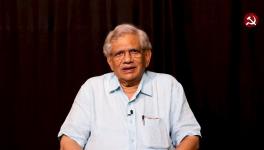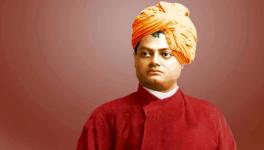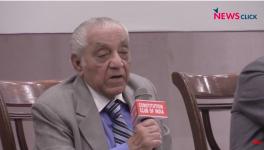"Selfless Patriot"

“It has been said with good reason that the Jana Sangh resulted from a combination of a partyless leader, Syama Prasad Mookerjee, and a leaderless party, the RSS”.
(The Jana Sangh: A Biography of an Indian Political Party, by Craig Baxter p. 54)
In Search of the "Selfless Patriot"
An untimely death of a political leader — whose career is just blossoming — is always a loss to the party they belong to, the ideology they espouse, or the cause(s) they pursue. It also leaves the field open for political pundits of different shades to make all sorts of speculations, or to involve themselves in endless deliberations about what would have been the future of the formation if the said person hadn’t died.
The death of Shyama Prasad Mukherjee (06 July 1901 – 23 June 1953), founder of Bharatiya Jana Sangh (precursor to the BJP), at the relatively young age of 52 years, can be considered one such loss for the project he had undertaken. One cannot stop thinking about how the party he helped found after resigning from Hindu Mahasabha would have developed had he remained alive. His differences with the Hindu Mahasabha, which he even led in 1944, were political in nature, and stemmed from the considered opinion that it abandoned its exclusivist character.
However, to his legatees, who are always bothered very little by the nuances and niceties, he is a leader who provides them a fig leaf to counter the criticism that they had played no role in freedom struggle, or had no place in the comprehensive list of 'makers of modern India'. Their ascension to the citadel of power has provided them with ample opportunity to project him as a key figure in the 'Making of India'. (https://thewire.in/politics/search-syama-prasad-mookerjee-true-patriot)
In addition to that, by repeatedly claiming that 'history failed to serve justice to Mukherjee,' they are able to easily target Jawaharlal Nehru, the first Prime Minister of India, who played the key role in institutionalising democracy after the assassination of Mahatma Gandhi and early demise of Sardar Patel, and was aware that any leeway to Hindu Supremacist ideology would lead India into becoming a mirror image of Pakistan — a Hindu Pakistan.
Questions remain as to whether Shyama Prasad Mukherjee was really the ‘selfless patriot’ his legatees want us to believe, or if the rulers then had paid heed to Mukherjee’s advice, would Kashmir really have been a different place by now.
Perhaps a perusal of his life and related events can throw some light on how to look at, or remember him.
Any such query would no doubt leave many uncomfortable questions for the saffrons themselves, regarding Shyama Prasad Mukherjee’s own political journey before independence and their continuous valorisation of his legacy without paying any heed to it.
If they take this arduous journey at all, they would also be confronted with his altogether different take on article 370 itself, and his emphasis on ‘abandoning communal composition of formations’ when Pakistan had become a reality.
2. A 'policy of responsive cooperation' with the Britishers
Born in 1901, Shyama Prasad Mukherjee started his political career in 1929, and became a member of the Bengal Legislative Council. He joined the Hindu Mahasabha in 1939 to espouse the cause of the Hindus in India and was a close associate of Savarkar. He was the opposition leader in the state when a coalition government led by Krishak Praja Party-Muslim League coalition was in power 1937-41. Later, he joined the Ministry headed by Fazlul Haq as the Finance Minister and continued to be in power during the tumultuous times of the Quit India Movement, when the Britishers faced a mortal challenge to their rule. The experiment to share power with Muslim League then was not limited to Bengal alone, it was extended to Sind, as well as to NWFP (North West Frontier Province), and was part of a conscious policy adopted by the Hindu Mahasabha.
Prof Shamsul Islam, in his well-researched book ‘Religious Dimensions of Indian Nationalism : A Study of RSS’ (Media House, Delhi, 2006) describes how ‘[H]indu Mahasabha and the Muslim League had a coalition government in the North Western Frontier Province (NWFP) also’ (Page 313). He quotes Baxter :
‘In the Frontier, Sardar Aurangzeb Khan formed a ministry which combined Muslim Leaguers, Sikh Akalis and Mahasabhaites, and placed the Congress led by Dr Khan Sahib temporarily in the opposition. The Mahasabha member of the Cabinet was Finance Minister Mehar Chand Khanna.’ (Craig Baxter, The Jana Sangh: A Biography of an Indian Political Party, (Philadelphia: University of Pennysylvania Press, 1969, P. 20)).
It is now history, how in 1942, when the Britishers were engaged in World War II and the Congress’s call for Quit India reverberated throughout India, thousands of people engaged in government jobs including police and military left their jobs to protest continuation of British regime, the formations espousing the cause of Hindutva adopted a compromising attitude. While the RSS preferred to keep itself aloof from the Quit India Movement, Savarkar, then Supremo of Hindu Mahasabha, went one step further. At the time, Savarkar opted to tour India, asking Hindu youth to join the military with the call ‘Militarise the Hindus, Hinduise the nation,’ thus strengthening British efforts to suppress the rising tide of people’s movement.
Savarkar’s address to the twenty fourth session of Hindu Mahasabha at Kanpur, where he outlined Hindu Mahasabha’s ‘policy of responsive cooperation’ with the British rule, is worth quoting:
The Hindu Mahasabha holds that the leading principle of all practical politics is the policy of responsive cooperation. And in virtue of it, it believes that all those Hindu Sangathanists who are working as councillors, ministers, legislators and conducting any municipal or any public bodies with a view to utilise those centres of government power […] are rendering a highly patriotic service to our nation. [...] The policy of responsive cooperation which covers the whole gamut of patriotic activities from unconditional co-operation right up to active and even armed resistance, will also keep adapting itself to the exigencies of the time, resources at our disposal and dictates of our national interest.
( V. D. Savarkar, Samagra Savarkar Wangmaya Hindu Rasthra Darshan (Collected works of V. D. Savarkar) Vol. VI, Maharashtra Prantik Hindusabha, Poona, 1963, p 474)
In fact, Savarkar was of the opinion that with banning of Congress in 1942 and its removal from “..[t]he political field as an open organisation… the Hindu Mahasabha alone was left to take up the task of conducting whatever ‘Indian National’ activities lay within its scope.’ (do – Page 475)
Defending the power sharing in different provinces Savarkar had famously said:
…in practical politics also the Mahasabha knows that we must advance through reasonable compromises. Witness the fact that only recently in Sind, the Sind Hindu Sabha on invitation had taken the responsibility of joining hands with the League itself in running coalition government.The case of Bengal is well known. Wild Leaguers whom even the Congress with all its submissiveness could not placate grew quite reasonably compromising and socialble as soon as they came in contact with the Hindu Mahasabha and the Coalition government , under the premiership of Mr Fazlul Haq and the able lead of our esteemed Mahasabha leader Dr. Shyama Prasad Mookerji, functioned successfully for a year or so to the benefit of both the communities.
(V. D. Savarkar, Samagra Savarkar Wangmaya Hindu Rasthra Darshan (Collected works of V. D. Savarkar) Vol. VI, Maharashtra Prantik Hindusabha, Poona, 1963, p 479-480)
As a close associate of Savarkar, Shyama Prasad Mukherjee, who later became the president of Hindu Mahasabha in 1944, was a party to all these decisions, and had no qualms agaiinst British efforts to suppress people’s movement against the British rule. In his book ‘History of Modern Bengal,’ Ramesh Chandra Mazumdar provides details of his letter to the then Bengal Governor, suggesting measures against the Quit India Movement. According to him
“[S]hyama Prasad ended the letter with a discussion of the mass movement organised by the Congress. He expressed the apprehension that the movement would create internal disorder and will endanger internal security during the war by exciting popular feeling and he opined that any government in power has to suppress it, but that according to him could not be done only by persecution…. In that letter he mentioned item wise the steps to be taken for dealing with the situation …. ” (Ramesh Ch. Mazumdar, History of Modern Bengal, Part II, pp. 350-351).
He was clearly of the opinion that
…Anybody, who during the war, plans to stir up mass feeling, resulting internal disturbances or insecurity, must be resisted by any Government that may function for the time being” (Prabhu Bapu (2013), Hindu Mahasabha in Colonial North India, 1915–1930: Constructing Nation and History. Routledge. pp. 103–. ISBN 978-0-415-67165-1)
He even promised the British government that the government led by them would make every effort to suppress the movement in Bengal. :
“The question is how to combat this movement (Quit India) in Bengal? The administration of the province should be carried on in such a manner that in spite of the best efforts of the Congress, this movement will fail to take root in the province. It should be possible for us, especially responsible Ministers, to be able to tell the public that the freedom for which the Congress has started the movement, already belongs to the representatives of the people. In some spheres it might be limited during the emergency. Indian have to trust the British, not for the sake for Britain, not for any advantage that the British might gain, but for the maintenance of the defense and freedom of the province itself. You, as Governor, will function as the constitutional head of the province and will be guided entirely on the advice of your Minister. (Abdul Gafoor Abdul Majeed Noorani (2000), The RSS and the BJP: A Division of Labour, LeftWord Books, pp. 56–, ISBN 978-81-87496-13-7)
3. Time for Hindu Mahasabha to abandon its 'communal composition’
What is noteworthy, is that with independence approaching, or with the partition becoming a reality, Mukherjee seemed to have realised the need for (majority) community based parties to shed their exclusiveness and become inclusive. If one goes into details of what prompted Shyamaprasad Mukherjee to leave Hindu Mahasabha, and what was his vision for the party which he founded with due support from RSS, we come across interesting facts that have not come to the fore earlier.
Mukherjee, who became president of Hindu Mahasabha after Savarkar resigned from the post in 1944, was of the opinion that after independence, membership of Hindu Mahasabha should not be restricted to Hindus alone (Statesman, 23 Nov 1948, Press Statement, (Calcutta), 24th Nov 1948, quoted in Hindu Nationalism and Indian Politics - The Origins and Development of Bharatiya Jana Sangh, B. D. Graham, Cambridge University Press, 1990). After Gandhi’s assassination, when public hostility was further directed towards Mahasabha, he declared on 6th February 1948 that
…[i]n my considered judgement the Hindu Mahasabha has today two alternatives before it. The first is that it can break away from its political activities and confine its attention to social, cultural and religious matters alone, it being open to its members to join such political parties as they may choose. The other alternative is for the Hindu Mahasabha to abandon its communal composition, to reorient its policy and throw its doors open to any citizen, irrespective of religion, who may be willing to accept its economic and political programme
( Mukherjee, Statement of 6th Feb 1948, Statesman, 7th Feb 1948, pp. 1 and 7, quoted in Hindu Nationalism and Indian Politics - The Origins and Development of Bharatiya Jana Sangh, B. D. Graham, Cambridge University Press, 1990)
Initially, it appeared that the Hindu Mahasabha was contemplating to revisit its overall policy, and also thinking about suspending political activities and concentrating on socio- cultural work, but it proved to be eyewash. The Working Committee meeting held in Delhi (6-7 Nov 1948) not only decided to resume political activities but also decided to restrict the membership to Hindus alone. Mukherjee resigned from the said committee on 23rd November, and his resignation was ratified by a meeting of the All India Committee on 26th December ( Statesman (Calcutta) 9th Nov 1948, 24th Nov 1948 and 27th December 1948, -do-)
And the manner in which he explained his position at the time of his resignation made it further explicit that there was no basis to form exclusive organisations of Hindus in Independent India
In the India of today more than 85 per cent of her people are Hindus and if they are unable to protect their own economic and political interests or India’s inherent rights through the working of a fully democratic constitution, no separate political party which would confine its membership to the Hindu fold alone could ever save Hindus or their country.
On the other hand, if the majority community itself retains its political exclusiveness it would inevitably encourage the growth of communal political organisations representing the interests of various minority groups within the country itself, leading to highly prejudicial results.
(Mukherjee, Press Statement, 23 Nov 1948, Statesman ( Calcutta) 24 th November 1948, p. 7, -do-)
These words no doubt would appear blasphemous to anyone who believes in Hindutva Supremacist worldview.
Mukherjee’s untimely death while the party he wanted to build was still in the stage of infancy, rather abruptly brought an end to the differing approaches vis-à-vis building of the organisation.
The unfolding debate around article 370 provides a glimpse of the differences which existed between them.
4. Article 370, Shyama Prasad Mukherjee and Bharatiya Jana Sangh
Not a day passes when name of Shyama Prasad Mukherjee, founder of Bharatiya Jana Sangh, is not invoked by BJP to oppose Article 370 which guarantees special status to Jammu and Kashmir. With new facts coming to the fore, this claim is under question now. It is being now said that Mukherjee, who died in 1953 under mysterious circumstances, after being arrested for opposing the special status to Kashmir, had initially accepted the inevitability of Article 370.
In fact, A. G. Noorani’s important book ‘Article 370: A Constitutional History of J and K’ (OUP, 2011, Pages 480) is able to clear many confusions about the tumultuous era post-independence, pertaining to Jammu and Kashmir.
Basing himself on authentic documents, letters, memorandums, white papers, proclamations and amendments, the author, a constitutional expert himself, has not only provided fresh insights into the period, but has also tried to bring forth an important summary of the developments then, and the role played by different stakeholders. While we have been witness to a process of erosion of the article 370 today, the book underscores the politics behind its erosion, which was negotiated between Prime Ministers Jawaharlal Nehru and Sheikh Abdullah, and had a stamp of approval from Sardar Patel and Shyama Prasad Mukherjee.
It is well known that ... Sardar Patel played an important role in getting the provision for J&K’s special status cleared by our Constituent Assembly. Contrary to the BJP-propagated opinion, Patel intervened in a dispute between some Congress party members opposed to the special status and Jawaharlal Nehru’s minister (without portfolio but entrusted with the task of dealing with the issue) Gopalaswamy Ayyangar to ensure the smooth passage of Article 370 (called 306 then).
(http://www.firstpost.com/politics/bjps-kashmir-conundrum-article-370-is…)
No doubt, for the BJP, this exposure that the said Article had full approval from Mukherjee, as well as then Home Minister Sardar Patel, is nothing but blasphemous. Despite its important bearing on its overall posturing, one is yet to come across any strong rebuttal from the saffron quarters to this claim till date, barring its usual rhetoric which says that it is an “[a]ttempt to distort history at the behest of separatist friendly pseudo-secularists and pseudo-intellectuals.” Interestingly, while lashing out at the contents of the book, Mr Jitendra Singh, the then spokesperson of BJP for J & K, and its National Executive Member, had rather indirectly acknowledged what the author wanted to convey by stating that “[T]he late leader had suggested to first Prime Minister Jawaharlal Nehru to put a time-bound rider on ‘Article 370’ and specify for how long it was being envisaged,” (http://www.siasat.com/english/news/shyama-prasad-mukherjee-never-endors…).
It is worth mentioning that this is not the first time that Dr Mukherjee’s consent to full autonomy to Kashmir has come up. In his article in ‘The Greater Kashmir’ (http://www.greaterkashmir.com/news/2010/aug/8/leaf-from-the-past-4.asp), Mr Balraj Puri, the veteran journalist from the state, has provided further details about the same:
“[S]hyama Prasad’s prolonged triangular correspondence with Nehru and Sheikh Abdullah on the status of the State, which was published at that time by the party, is the most authentic evidence of his stand on the issue. In his letter dated January 9, 1953 to both of them, for instance, he wrote: “We would readily agree to treat the valley with Sheikh Abdullah as the head in any special manner and for such time as he would like but Jammu and Ladakh must be fully integrated with India.” While Nehru rejected the idea straightway warning against its repercussions in Kashmir and its international implications, Abdullah sent a detailed reply in which he, inter alia, said. “You are perhaps not unaware of the attempts that are being made by Pakistan and other interested quarters to force a decision for disrupting the unity of the State. Once the ranks of the State people are divided, any solution can be foisted on them.”
He further added that the prolonged correspondence is concluded with Dr. Mukherjee’s letter to Pandit Nehru on February 17, 1953, in which he suggested.
1. “Both parties reiterate that the unity of the State will be maintained and that the principle of autonomy will apply to the province of Jammu and also to Ladakh and Kashmir Valley.
2. Implementation of Delhi agreement—which granted special status to the State—will be made at the next session of Jammu and Kashmir Constituent Assembly.”
Nehru replied to that by saying that the proposal for autonomy to the three provinces had been accepted by him and Abdullah in July 1952. If Mukherjee had realised his mistake, he should have withdrawn the agitation unconditionally. Mukherjee was unwilling to do so, as it amounted to surrender. The deadlock prolonged over some way which could provide, what may be called, a face saving to the Jana Sangh.
It is important to note that after the sudden death of Mukherjee, Nehru had appealed to the people of Jammu to withdraw their agitation as their demand for regional autonomy had been conceded. The State government endorsed the appeal on July 2, when Praja Parishad leaders were released, went to Delhi and met Nehru on July 3. Thus, the Praja Parishad agitation was withdrawn on the assurance of regional autonomy and immediate implementation of the Delhi Agreement.
But there are number of ifs and buts. One factor which prevented its implementation was that Praja Parishad and Jana Sangh backed out of it. According to Balraj Madhok, who later on became the president of the Jana Sangh, the party withdrew its commitment to the State autonomy and regional autonomy under the directive from Nagpur (the RSS headquarters).The party continued a ceaseless campaign against regional autonomy and Article 370.
((http://www.greaterkashmir.com/news/2010/aug/8/leaf-from-the-past-4.asp))
Till date the BJP maintains that if the government then had paid heed to Mukherjee’s opposition of the said Article, Kashmir would have been in a different situation right now, but it still has not gathered enough courage to admit that he had conceded to the proposal in writing, earlier.
Get the latest reports & analysis with people's perspective on Protests, movements & deep analytical videos, discussions of the current affairs in your Telegram app. Subscribe to NewsClick's Telegram channel & get Real-Time updates on stories, as they get published on our website.
























